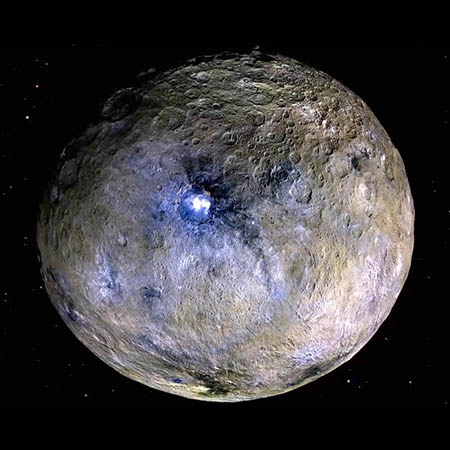Ceres
Ceres is named for the Roman goddess of corn and harvests.
Scientists describe Ceres as an "embryonic planet." Gravitational perturbations from Jupiter billions of years ago prevented it from becoming a full-fledged planet. Ceres ended up among the leftover debris of planetary formation in the main asteroid belt between Mars and Jupiter.
NASA's Hubble Space Telescope observed that Ceres' rotation demonstrates that it has a nearly round body. Ceres' diameter at its equator is wider than at its poles. Ceres is approximately 590 miles (950 kilometers) across, about the size of Texas. And even though Ceres comprises 25 percent of the asteroid belt's total mass, tiny Pluto is still 14 times more massive.
But Ceres has more in common with Earth and Mars than its rocky neighbors. There are signs that Ceres contains large amounts of pure water ice beneath its surface. Scientists using the Herschel Space Observatory found evidence for water vapor on Ceres: plumes of water vapor are thought to shoot up periodically from Ceres when portions of its icy surface are warmed by the sun during the course of its orbit. This proves that Ceres has a icy surface and an atmosphere as well. Astronomers estimate that if Ceres were composed of 25 percent water, it may have more water than all the fresh water on Earth. Ceres' water, unlike Earth's, would be in the form of water ice and located in the mantle, which wraps around the asteroid's solid core.
Also, observations by NASA's Hubble Space Telescope show that Ceres shares characteristics of the rocky, terrestrial planets of our inner solar system. Computer models show that nearly round objects such as Ceres have a differentiated interior, with denser material at the core and lighter minerals near the surface. All the terrestrial planets -- including Earth -- have differentiated interiors. This sets Ceres apart from its asteroid neighbors.
Ceres was the first object discovered in the asteroid belt. Sicilian astronomer Father Giuseppe Piazzi spotted the object in 1801. Piazzi was looking for suspected planets in the large gap between the orbits of Mars and Jupiter. As more such objects were found in the same region, they became known as asteroids or minor planets. Ceres was initially classified as a planet and later classified as an asteroid. In recognition of its planet-like qualities, Ceres was designated a dwarf planet in 2006 along with Pluto and Eris.
When the Dawn probe arrived in 2015, Ceres became the first dwarf planet to be visited by a spacecraft.
| Ceres facts | |
| Discovered By | Giuseppe Piazzi |
| Date of Discovery | 1 Jan. 1801 |
| Semi-major axis | 413,690,250 km |
| Perihelion | 380,951,528 km |
| Aphelion | 446,428,973 km |
| Orbit Period | 4.60 years |
| Average Orbit Velocity | 64,360 km/h |
| Orbit Eccentricity | 0.079 |
| Orbit Inclination | 10.59° |
| Mean Radius | 476.2 km |
| Volume | 452,331,448 km3 |
| Mass | 9.47 x 1020 kg |
| Density | 2.09 g/cm3 |
| Surface Gravity | 0.28 m/s2 |
| Escape Velocity | 1,855 km/h |
| Rotation period | 9.07417 hours |
Información: NASA, Solar System Exploration.

